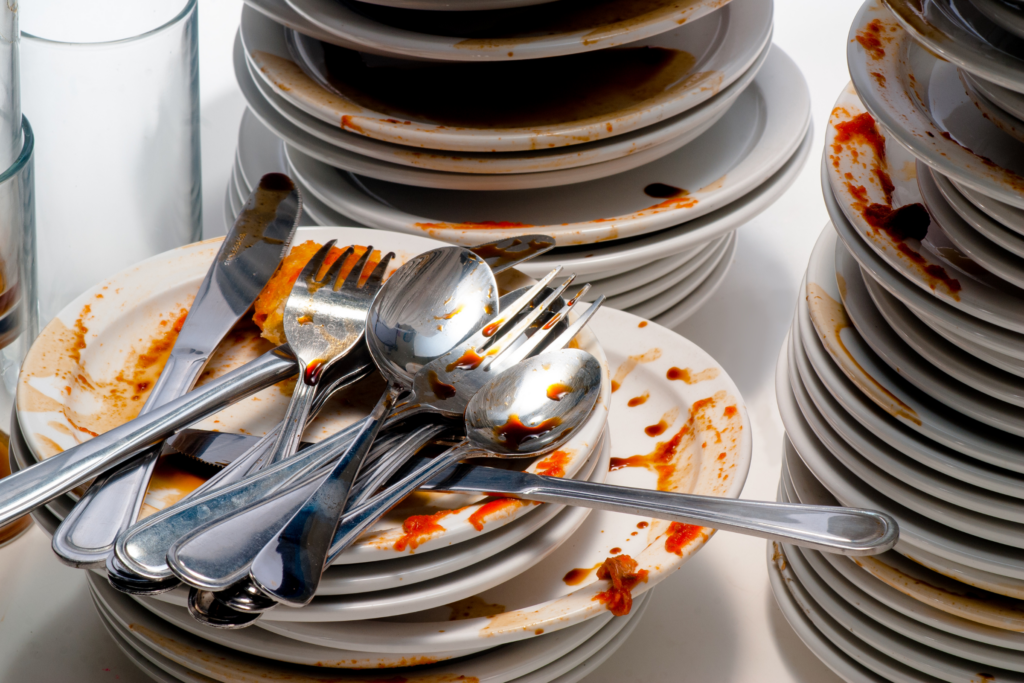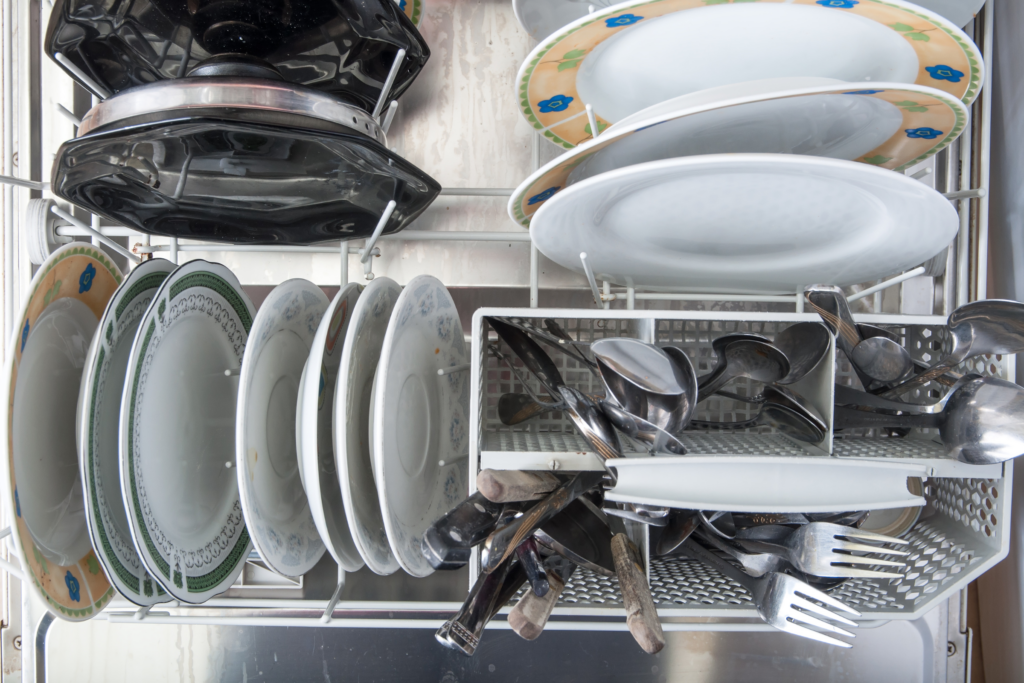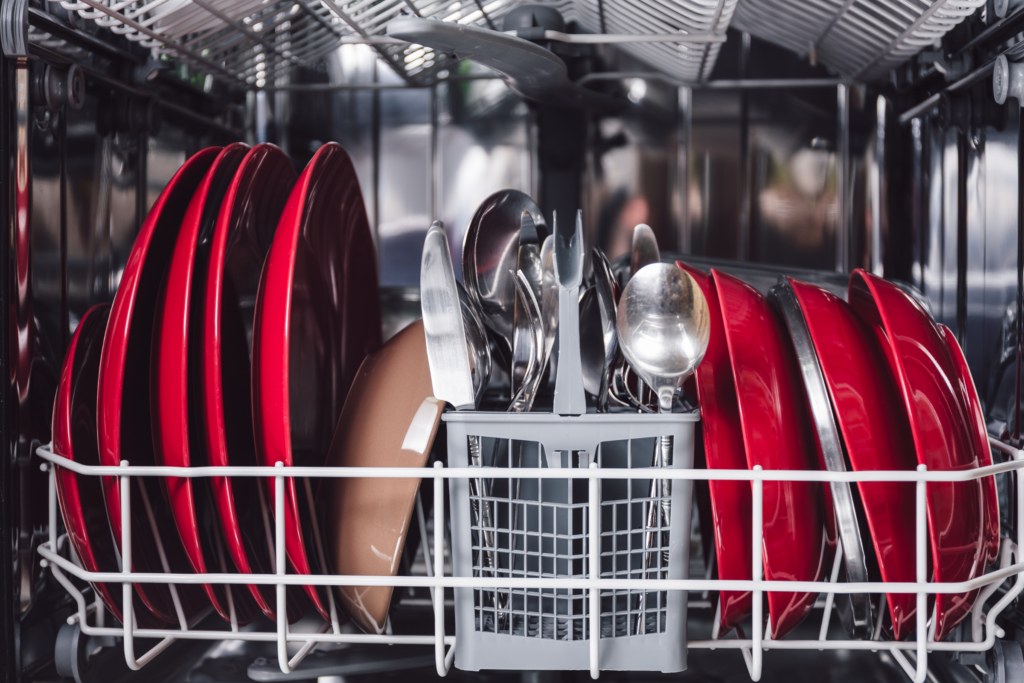6 Frigidaire Dishwasher Wash Cycles (How Long & Hot) – Pros & Cons
If you have a Frigidaire dishwasher, you’ve likely noticed how efficient and reliable it is in cleaning your dishes. But all those settings can be a bit overwhelming!
So, let’s explain all of the Frigidaire dishwasher cycles and options! I’ve poured through the Frigidaire owner’s manuals and technical data sheets to pull out the most useful and practical info for you!
With a Frigidaire dishwasher, you can choose from several cycles, including heavy, normal, 30-minute, China or Crystal, Energy Saver, and rinse only. Most models come with these 6 primary cycles and have additional options for hi-temp, surge, sanitize, and heated dry.
Read on to learn more about the specifics of how long each wash cycle is, how hot they gets, pros, cons, and more about the most useful appliance sitting on the kitchen floor!
Frigidaire dishwasher cycles explained (all of them!)
Most new Frigidaire dishwashers offer 6 different wash cycles to cater to a variety of cleaning needs. From “Normal,” which uses sensors to adjust settings for mixed loads, to “China Crystal” which uses a gentle wash temp and agitation, there is a setting for any scenario.
“30-minute” and “Energy Saver” are designed to use less water and for speed and lightly soiled items, while “Heavy Wash” aims for thorough cleaning of super dirty dishes.
“Rinse-only Cycle” offers a quick rinse before full washing.
| Cycle Name | Duration (Minutes) | Temperature (°F) | Ideal For | Energy Efficiency | Options |
|---|---|---|---|---|---|
| Heavy | 140-200 minutes | 120-170 °F | Pots, pans casseroles and dinnerware with dried-on or baked-on soils | Low | Surge, Hi-Temp, Heated Dry |
| Normal | 120-200 minutes | 120-150 °F | Regularly soiled dishes and silverware. | Moderate | Surge, scour-spray, Hi-temp, Sanitize |
| 30-minute | 30 minutes | ~120 °F | Lightly soiled dishes and silverware | High | Surge |
| China Crystal | ~45 minutes | ~120 °F | For lightly soiled China and Crystal | High | Normal Heat and Spray |
| Energy Saver | 75-105 minutes | 120-140 | For lightly soiled pre-rinsed dishes and silverware | Moderate | Not for heavily soiled dishes |
| Rinse Only | 20 minutes | ~140 | For rinsing dishes that will be washed later. | High | Surge |
1. Heavy Wash

How long is it?
The heavy wash cycle typically lasts approximately 120-170 minutes. However, the duration may vary based on the dishwasher’s assessment of the load’s requirements.
How hot is it?
The heavy wash cycle uses high-temperature water, typically around 150°F (65°C) or more, to effectively remove tough, baked-on food residues from dishes.
Pros
- Thoroughly cleans heavily soiled dishes and cookware
- High-temperature water can help sanitize dishes, making it ideal for pots and pans with stubborn grease
- Removes tough food residue, reducing the need to soak or pre-wash dishes
Cons
- Longer wash time compared to other cycles
- Uses more water and energy due to the higher temperatures and extended wash time
- May not be suitable for delicate items, like fine china or plasticware
2. Normal or Auto Wash

How long is it?
The length of a Normal or Auto Wash cycle in a Frigidaire dishwasher may vary from around 120-200 minutes, depending on the load size and level of soil on the dishes. The cycle time may also change based on the specific model of the dishwasher.
How hot is it?
During a Normal or Auto Wash cycle, the temperature of the water in a Frigidaire dishwasher usually ranges between 120°F and 150°F. The dishwasher’s sensors detect the amount of dirt on the dishes and adjust the water temperature accordingly for optimal cleaning results.
Pros
- Efficient cleaning: The Normal or Auto Wash cycle effectively cleans your dishes, adjusting the intensity and heat level based on the dirtiness of the load.
- Energy-saving: This cycle uses energy and water efficiently, as it adjusts the cycle duration and water temperature according to the needs of each load.
- Suitable for a variety of dishes: The Normal or Auto Wash cycle can handle different types of dishes and utensils – from lightly to heavily soiled items.
Cons
- Longer cycle time: Compared to quick wash cycles, the Normal or Auto Wash cycle can take more time (up to 130 minutes) to complete.
- Potentially higher energy consumption: If the dishwasher sensor detects a heavily soiled load, it may increase the water temperature and cycle duration, leading to higher energy consumption than faster or shorter cycles for smaller or less soiled loads.
3. 30-Minute Wash

How long is it?
The 30-minute wash is a quick cycle designed to clean lightly soiled dishes in just 30 minutes.
How hot is it?
The exact temperature of the 30-minute wash cycle may vary between different Frigidaire dishwasher models. Generally, quick wash cycles use a slightly lower temperature than standard cycles to save time and energy. To find the precise temperature for your specific dishwasher model, consult its user manual.
Pros
- Time-saving: The 30-minute wash cycle significantly reduces the time required to wash dishes compared to a regular cycle, making it ideal when you’re in a hurry.
- Energy-efficient: As the cycle uses a lower temperature and runs for a shorter duration, it consumes less energy than regular cycles.
- Light loads: This cycle is effective for washing less than half a load of dishes or silverware that are only lightly soiled.
Cons
- Less effective on heavily soiled dishes: The short duration and lower temperature of the 30-minute wash cycle make it less effective on heavily soiled or greasy dishes.
- May require pre-rinsing: If dishes have large food particles or are heavily soiled, you may need to pre-rinse them to ensure a proper cleaning in the 30-minute cycle.
4. China and Crystal Wash

How long is it?
The China and Crystal Wash cycle on a Frigidaire dishwasher typically lasts for approximately 45 minutes. However, the exact duration may vary depending on the specific model of dishwasher you have.
How hot is it?
This cycle uses a lower water temperature, usually around 120°F, to gently clean delicate items like china and crystal glassware. The reduced heat helps prevent damage to your fragile dishes while still providing effective cleaning.
Pros
- Ideal for delicate items such as china, crystal, and fine glassware
- Lower water temperature reduces the risk of damage caused by high heat
- Gently cleans dishes while maintaining their quality and appearance
Cons
- Not suitable for heavily soiled or greasy dishes, as the gentle cycle may not provide enough cleaning power
- Longer cycle duration compared to regular wash cycles
- Lower temperature and gentle wash may not fully sanitize dishes
5. Energy Saver Wash
How long is it?
The Energy Saver cycle on a Frigidaire dishwasher usually takes somewhere between 75-105 minutes to complete. The duration may vary depending on the model and the amount of energy that needs to be conserved.
In order to save energy, this cycle typically uses less water, heat, and time as compared to other standard washing cycles.
How hot is it?
The temperature range of the Energy Saver cycle varies with different Frigidaire dishwasher models. However, many models have an energy saver cycle temperature range of around 120°F to 140°F. Though this is slightly cooler than other regular wash cycles, it still provides an effective cleaning performance while conserving energy.
Pros
- Energy Efficiency: The Energy Saver cycle is designed to save energy by reducing water and heat consumption compared to other dishwasher cycles.
- Cost Savings: Since it consumes less energy, the Energy Saver cycle, in the long run, can help reduce your utility bills and be more economical.
- Environmental Impact: By using less energy, this cycle helps reduce the carbon footprint and contributes to a more sustainable lifestyle.
Cons
- Cleaning Performance: The Energy Saver wash may not be as effective in removing stubborn stains or dried-on food particles due to the lower heat and water consumption.
- Longer Cycle Time: As the cycle is designed to save energy, it might take longer to complete compared to other standard wash cycles.
6. Sanitize Mode

How long is it?
The sanitize mode on Frigidaire dishwasher models heats water for the final rinse cycle to 155 degrees Fahrenheit for approximately nine minutes. This cycle ensures thorough cleaning and effective sanitization of your dishes.
How hot is it?
During the sanitize cycle, the water temperature rises to a minimum of 155 degrees Fahrenheit, but some dishwashers can reach even higher temperatures, such as 170 degrees Fahrenheit.
Compared to a normal cycle with temperatures between 120 and 150 degrees Fahrenheit, the sanitize cycle provides an extended hot-water rinse that helps kill germs and eliminate bacteria on your kitchenware.
Pros
- Kills germs and bacteria effectively, ensuring a higher level of cleanliness.
- Can help reduce the risk of spreading foodborne illnesses in your home.
- May provide better cleaning results for heavily soiled dishes and cookware.
Cons
- Sanitize mode consumes more energy and water due to the higher temperatures and extended wash time.
- Some delicate items or materials might be sensitive to high temperatures and could get damaged during this cycle.
- The sanitize cycle may not be suitable for all types of dishes and materials, requiring you to check the manufacturer’s recommendations for each item.
7. Heated Dry Mode

How long is it?
In most Frigidaire dishwashers, the heated dry cycle adds around 30 minutes to the total wash cycle time. The length of this cycle may vary slightly depending on the specific model of your dishwasher.
How hot is it?
The heated dry cycle uses hot air to remove any remaining moisture from your dishes. The exact temperature may vary, but it is generally high enough to evaporate the moisture effectively, typically between 120 and 160 degrees Fahrenheit.
Pros
- Faster drying: Compared to air-drying, heated dry can significantly speed up the drying process.
- Less need for hand-drying: By using heated dry, you can minimize the need for additional hand-drying after the cycle is complete.
- PowerPlus Dry Cycle: Some Frigidaire models offer a PowerPlus Dry option, which adds a forced air system to the heated dry cycle for even better drying results.
Cons
- Increased energy use: The heated dry cycle uses more energy than air-drying as it heats the air to a high temperature. This can translate to higher electricity costs over time.
- Potential for damage: Extended use of heated dry on your dishes could potentially lead to signs of damage or wear, especially on delicate or sensitive materials.
Remember to always use your Frigidaire dishwasher’s features in the most efficient way possible, depending on your specific needs, preferences, and energy-saving goals.
Which Frigidaire Dishwasher Cycle is the Best?
To choose the best Frigidaire dishwasher cycle, consider the kind of dishes and cookware, the level of dirt, and the specific cleaning requirements. Here’s a quick guide to help you choose the most suitable cycle:
- Normal Wash: Suitable for everyday dishes with mild to moderate dirt. This cycle works well for regular plates, glassware, and silverware.
- Heavy Wash: Ideal for tough stains and heavily soiled cookware, like pots and pans from a dinner party.
- 30-minute Wash: Use this cycle for lightly soiled dishes and when you have less than half a load. Keep in mind that Air Dry is used in Quick/Express cycles rather than heated dry, so dishes might not dry completely.
Remember to load your dishwasher correctly, with dirty dishes facing down, and use the appropriate amount of detergent for maximum cleaning efficiency. You can also explore add-ons for drying, sanitization, and delay start options to enhance your dishwasher’s performance.
When should you NOT use the normal cycle on a Frigidaire dishwasher?
There are certain situations when you should avoid using the normal wash cycle on your Frigidaire dishwasher and opt for the auto wash cycle instead:
- Heavily soiled dishes: Auto wash cycles have built-in sensors that can determine the level of dirt and adjust the cleaning mechanism accordingly. Normal cycles might not be as effective in dealing with heavily soiled dishes.
- Energy conservation: If you’re looking to save energy, an auto wash cycle can optimize energy consumption by adjusting the cycle duration and temperature, unlike the normal cycle.
- Mixed loads: When you have a mix of everyday dishes and delicate items, the auto wash cycle can find the right balance between cleaning power and care. Normal cycles may not cater to the specific needs of varied items in the dishwasher.
Remember, the auto wash cycle may take longer than the normal cycle (95 to 135 minutes) but it provides a more tailored and efficient cleaning approach for your dishes. So, whenever appropriate, go for the auto wash cycle instead of the normal cycle to enjoy better washing performance and energy savings.
Can you stop your Frigidaire dishwasher during a cycle?
Most modern Frigidaire dishwashers allow you to stop a cycle after it has started, although the specific method may vary depending on the model.
Usually, you can stop a cycle by opening the dishwasher door or pressing a stop, cancel, or pause button on the control panel before you try to open the door.
However, it’s important to exercise caution when interrupting a cycle, especially during high-temperature wash or sanitize cycles, as hot water could spill out and cause burns.
After stopping a cycle, the dishwasher may go through a drain phase before allowing you to open the door completely. Always consult your dishwasher’s user manual for specific instructions and safety guidelines related to interrupting a wash cycle.
What if you open the door mid-cycle on a Frigidaire dishwasher
If you need to pause your Frigidaire dishwasher during a cycle, press the cycle selector button.
The dishwasher will stop its operation and the door will unlock when it’s safe to reach inside the machine. To resume the cycle from where it left off, simply press the cycle selector button again1.
Here’s a quick step-by-step guide on how to pause or cancel a cycle:
- Press the cycle selector button to pause the dishwasher during a cycle.
- Wait for the door to unlock before opening it.
- To resume the cycle, press the cycle selector button again.
- To cancel a cycle, press and hold the cycle selector button for 10 seconds1.
In case you open the door mid-cycle without pausing the dishwasher first, some models may automatically pause the cycle. However, others may continue running, leading to potential safety issues such as hot water splashing out of the dishwasher. Always pause the cycle before opening the door.
Let Us Know How We’re Doing!
Did this expertly prepared resource answer your question?
Do you have another question about home maintenance, home improvement projects, home appliance repair, or something else?
Get more information, send in questions and keep the discussion going by contacting the I’ll Just Fix It Myself company customer service team at at 1-800-928-1490 or Email us at [email protected]
